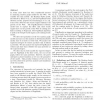Free Online Productivity Tools
i2Speak
i2Symbol
i2OCR
iTex2Img
iWeb2Print
iWeb2Shot
i2Type
iPdf2Split
iPdf2Merge
i2Bopomofo
i2Arabic
i2Style
i2Image
i2PDF
iLatex2Rtf
Sci2ools
SODA
2008
ACM
2008
ACM
PageRank and the random surfer model
In recent years there has been considerable interest in analyzing random graph models for the Web. We consider two such models - the Random Surfer model, introduced by Blum et al. [7], and the PageRank-based selection model, proposed by Pandurangan et al. [18]. It has been observed that search engines influence the growth of the Web. The PageRank-based selection model tries to capture the effect that these search engines have on the growth of the Web by adding new links according to Pagerank. The PageRank algorithm is used in the Google search engine [1] for ranking search results. We show the equivalence of the two random graph models and carry out the analysis in the Random Surfer model, since it is easier to work with. We analyze the expected in-degree of vertices and show that it follows a powerlaw. We also analyze the expected PageRank of vertices and show that it follows the same powerlaw as the expected degree. We show that in both models the expected degree and the PageRank of...
Algorithms | PageRank-based Selection Model | Random Graph Models | Random Surfer Model | SODA 2008 |
| Added | 30 Oct 2010 |
| Updated | 30 Oct 2010 |
| Type | Conference |
| Year | 2008 |
| Where | SODA |
| Authors | Prasad Chebolu, Páll Melsted |
Comments (0)

